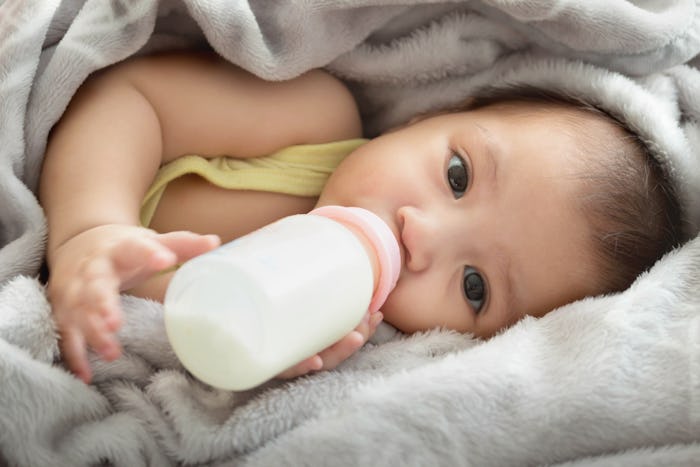Life

Here's What You Need To Know Before You Give Baby Cold Milk From The Fridge
Breastfeeding brings up a lot of tough questions: Is my baby latching? Should I really chug a beer right now to boost my supply? Can boobs actually explode? In those moments when you don’t have a lot of time to warm a bottle or it's the middle of the night and your baby is hangry, you may also wonder (and hope) that babies can drink cold breast milk, because it would just make life easier.
“There isn't an ideal temperature for serving breast milk, provided it won't be too hot and burn baby, of course,” Kristin Gourley, IBCLC with Lactation Link LLC tells Romper. “Sometimes very young babies need it to be warmer to prevent any loss of temperature before they can control their temperature well. But it's okay to feed most babies cold breast milk.” Babies who are born prematurely may have trouble regulating their temperature due to low body fat, according to The Children's Hospital of Philadelphia, so if you your baby is a preemie or if you live in an especially cold environment, it's probably best to stick with warm milk. Otherwise, cold is a go!
Bear in mind though, frigid milk may be a surprise to your baby (and they may make a really cute, shocked face after the first sip). “You can feed expressed milk straight from the fridge if your baby is happy drinking it cold,” Abie Iyare, Pediatrician and Medical Director of Weiler Newborn Nursery Service at Children's Hospital at Montefiore tells Romper. “Or you can warm the milk to room temperature if your baby prefers it that way.”
Of course, your infant can't talk, so you can’t just straight-up ask them if they prefer warm or cold milk like you’re some sort of breast milk barista. However, you know your baby best and you’ll likely start to learn their preference cues which may include swatting the bottle or turning their head away.
If you do decide to warm the milk, “the best way to heat breast milk is to put the bag or bottle of milk into a cup filled will warm water from the sink,” Gourley advises. “You can switch out the water with new warm water as it cools ... to help speed the process.”
The process of thawing or warming milk can be time consuming, but it’s important to do it properly. “Do NOT heat milk directly on the stove or in the microwave,” Iyare says. Microwaves don't evenly heat, so they can create hot spots within the milk that may burn your baby, plus, “microwaving can destroy nutrients in breast milk,” per The Centers For Disease Control and Prevention.
Test the temperature of the heated milk by sprinkling a few drops on your wrist. “It should feel warm, not hot,” Iyare says. “Swirl the milk to mix the fat, which may have separated. If your baby did not finish the bottle, the leftover breast milk can still be used within two hours after the baby is finished feeding.”
Milk that gets too hot is actually much more of an issue than cold breast milk. According to a 2015 study published in PLOS One, “human milk is often heated in electrical-based bottle warmers that can exceed 80 degrees Celsius, a temperature at which many beneficial human milk properties disappear.” 80 degrees Celsius is approximately 176 degrees Fahrenheit, and an earlier study published in Pediatric Research found that enzymes in breast milk start to deteriorate at as low as 120 degrees Fahrenheit.
If you forget to put your pumped supply directly into the freezer or refrigerator (so frustrating!) all may not be lost. “Breast milk is good at room temperature for four to eight hours, depending on how cool or hot the actual room is,” Gurney tells Romper. She adds that it’s fine to “pump before leaving and leave out the bottle for an hour or two when your caregiver will then give to the baby without warming. [After] four to eight hours and the milk can start growing bacteria.”
Colder milk is more likely to, “stick to the side of the bottle which can be tricky,” Gurney says. The milk remnants that you see clinging to the body is usually comprised mostly of fat (which is important for growth) and swirling the cool milk before feeding will help it to blend more seamlessly.
So the next time you or your partner find yourself bleary eyed at two in the morning feeding your kiddo a cold bottle, rest assured that this is safe, and your baby is probably happy just to be eating. (A feeling I, too, know well.)
Studies referenced:
Bransburg-Zabary S., et al. (2015). Human milk warming temperatures using a simulation of currently available storage and warming methods. PLoS One. https://journals.plos.org/plosone/article?id=10.1371/journal.pone.0128806
Wardell JM., et al. (1984). Bile salt-stimulated lipase and esterase activity in human milk after collection, storage, and heating: nutritional implications. Pediatric Research. https://www.nature.com/articles/pr198474
Experts:
Kristin Gourley, IBCLC Manager at Lactation Link LLC
Abie Iyare, MD and Medical Director, Weiler Newborn Nursery Service at Children's Hospital at Montefiore
This article was originally published on